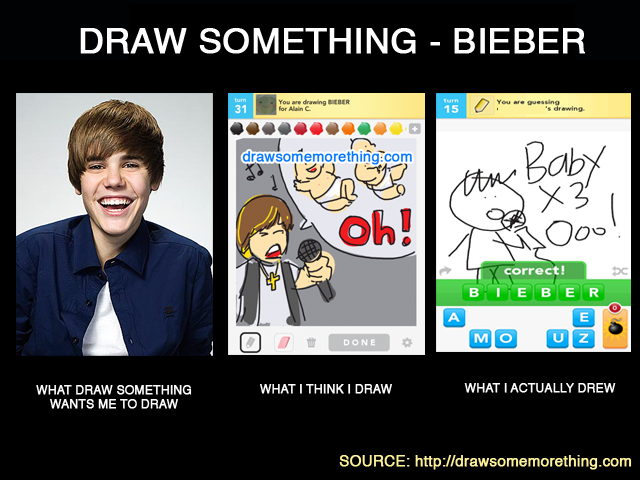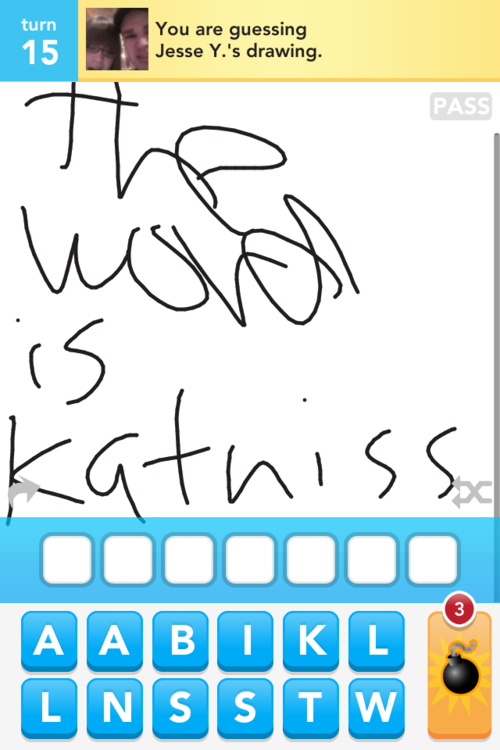My coworker told me, “Download Draw Something and watch your
next 3 hours disappear.” I did exactly that, marveling that anything save
heroin and cigarettes could be quite as addictive as purported. Like 14
million other users, I was immediately and almost irreparably hooked on the
game, which is a colorful, capacitive-screen update of the classic Pictionary.
At first I was rather rudimentary in my drawings—turning out
good-enough hieroglyphs for friends and strangers to guess. Then I took a turn
with an especially creative friend who rendered me a werewolf with more
character than you see on a CBS sitcom. Then on tumblr, I stumbled upon some truly inspired Drawn Somethings.
I suddenly realized this game could be so much more. To paraphrase a statement
I read online but cannot readily source, “Draw Something is like commissioning
tiny paintings from my friends.” Once I got an iPad, I reveled in going
completely overboard to render something simple.
My hours on Draw Something have yet to rival Angry Birds
levels of obsessiveness, but I admit to spending more than a healthy amount of
time playing. All this time has got me thinking about why this game fascinates
me so much. Its addictive properties are well
documented, but my brain has been tickling: Does the game get in touch with something deeper about our minds and our culture? And why do I like it so darn much. So here is some of what Draw Something represents to me.
The Psychology of
Symbolism
I’m a classically trained artist. The number one rule
drilled into my head during my decade and a half of arts education was not to
symbolize. In other words, draw what you see not what you think you see.
Eschewing symbolism was tremendous for my ability to render from reality,
allowing me to excel in portraiture.
But symbolism is exactly what makes art so communicative.
It’s why we can communicate with images that are not photographs—paintings,
cartoons, and Draw Something doodles alike. Our brains combine information from
various sources to create a unified interpretation of an image, even if we have
never seen that image before. Certain shapes, colors, objects, etc. signify
meaning within and among cultures.
Much of this symbolism is learned, through experience,
education, and acculturation. This aspect of Draw Something fascinated me
because it emphasized how I share intellectual and cultural development with
other people (more on this in a bit). But even more fascinating to me is our shared ability to
interpret symbols even beyond what we are taught. For example, it takes just
three marks to make a face.
:)
It doesn't look anything like a face; however, the signifier is undeniable. But it’s not something
we’re taught, like the Pythagorean Theorum; it’s actually a skill we’re born
with. Babies can recognize faces (as distinct from non-faces) at just 3 months
old. Moreover, studies
demonstrate that humans have a unique, inherited, genetic ability to
recognize faces where none should
reasonably exist.
Intellectually, we know this
But our evolutionary
instincts take over and translate the symbol—in case, you know, that face
is someone trying to steal your food or kill your young. It’s also why all
three of these examples work equally well to convey meaning:
In a strange way, I feel like Draw Something is letting me
connect with other people on a more basic level—while also connecting with them
on a more complex level, which brings me to:
Personalities, Predilections
Revealed
When symbols are not hardwired in our brains, diversity in
interpretation becomes the challenge, with varying degrees of severity. Symbols
have vastly changed over time. Think about the cross, which was once a
symbol of a terrifying
death, or the Nazi swastika,
which once symbolized
peace and harmony. With sharing-propelled
pop culture, signifiers changes even faster. And that’s part of the fun.
Playing Draw Something with a diverse group of people can
make the lowest common denominator of symbol rise to the top. Take the clue
“Easter.” It’s interesting that most of
my teammates drew a bunny and eggs. One friend drew the stone rolled away from
the tomb. The word “wreck,” as another example, is a free-for-all.
The interpretation a person chooses tells so much about
their personality that couldn’t quite be seen any other way. It’s a peek inside
the way they interpret words, and moreover, the way they think you
interpret words. It’s a melding of the mind, like Stephen King’s “mind-reading
trick” in On Writing.
Going the other way, you have to know your
audience. For me, a big part of the fun is choosing an interpretation that
will hopefully provide a big of amusement for my partner, as well as get a
correct guess. And I definitely tend to land on the “obscurer the better” end
of the spectrum. I am proud to have friends for whom I could draw something
like this and get a correct answer:

For others, it would look a lot more like this:
I recently realized through a number of contextual clues
that one of my DS partners was likely British. A brief mental retrospective
over our 72-turn streak made me wonder if I would have drawn anything
differently if I had realized that earlier. Then again, I probably don’t even
know what he might
not know. I like to have to second-guess what I may lazily consider
universal; it reminds me that the world is a lot bigger than I am.
The Absence of Words
I mentioned above that I have substantial art training, but
by trade I am a writer.
I read and manipulate words all day long, nearly every day. A forum, no matter
how small, where I cannot use any words at all to communicate is like a tiny
brain oasis.
Definitely part of the fun for me is eschewing ALL letters
and numbers in favor of images and symbols only. It’s the absence of language,
which is at once uniting and dividing. Remove language, and you remove a
lot of the barriers to communication. In my professional life, I write business
proposals and we strive to convey as much information in graphics
rather than in words for the very simple reason that graphics are more
efficient for communicating certain types of information.
Of course, part of the point of Draw Something is that it’s inefficient. While there are no
documented rules, many hardliners pooh-pooh any use of words (or actively call it out). For
my part, I never use words, letters, or numbers, but I won’t quit a game with
someone just because they do—unless it’s seriously blatant. Because what’s the
fun in this?
The second part of the joy I get in the absence of words is
that communication is absolutely reduced to the task at hand—at least until the
latest
update. Previously, your drawing had to speak for itself. And the only
praise you got was a correct guess. If you felt really compelled to applaud
your partner for a particular mini-masterpiece, you could squiggle out an
awkward “Awesome!” with your finger, then trash the drawing and get onto the
task. But that was it. It felt elementary—rudimentary and joyful as finger
painting. But in the days of the like
button, endless streams of comments, and retweeting, I think we’ve all gone
a little too far in our hunger for e-validation. Draw Something was a little
respite from the constant approval mongering. Which brings me to…
The Joy of Creating
in a Vacuum
If I spent a lot of extra time drawing a really special
“Lennon” for you, it was because I wanted to do that—for you and for myself.
Because it was hopefully a little highlight to both of our days. Sure, I may
dash off a quick “bride” before I go to sleep. But in large part, I try to spend
some time on my little doodles. There’s no countdown clock, no extra coins for
getting done faster. In a world where everything seems reduced to its most
streamlined 140 characters, where every task seems multitasked, it’s nice for
me to slow down while I’m drawing for you—and for you to slow down while you
watch me draw it.
More than that, the drawings used to disappear as soon as
they were sent. Sure, you could capture a screenshot (and
many have) but that wasn’t really in the spirit of things. For the most
part, the “tiny paintings” were a fleeting pleasure, shared between you and
your DS partner. I was disappointed that the update not only lets you save your
drawings, but has buttons for sharing them on the social network. The small pleasure
of creating in a vacuum, just for the sheer joy of doing it, has been reduced
like so many other things as a means to get
attention.
The changes brought about by the update didn’t surprise me—especially after the
OMGPOP CEO showed his true
colors, comparing
DS to Information Age behemoths AOL and Facebook. His true motive (not that
I blame him) is to sell as many apps as possible to demanding consumers who
have had their tastes cultivated for them by the prevailing social media, not
to preserve a neat little microcosm of culture—pop and otherwise.
But I still love the game, and I’ll still play for all the
reasons cited above. But I’m keeping it between you and me.









No comments:
Post a Comment